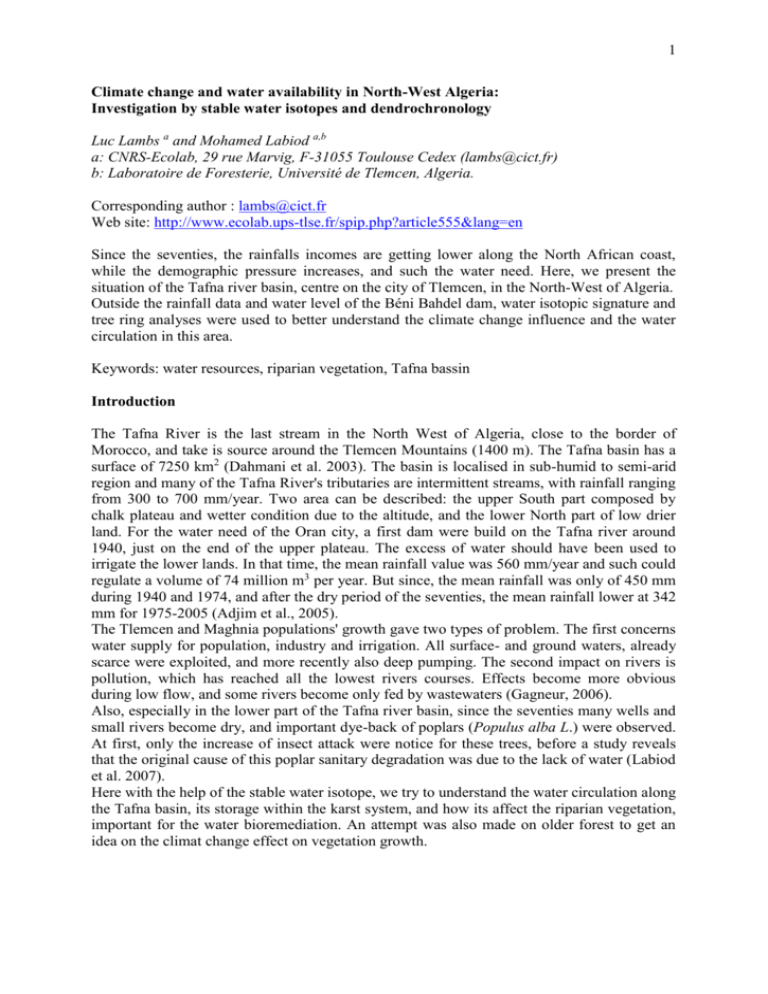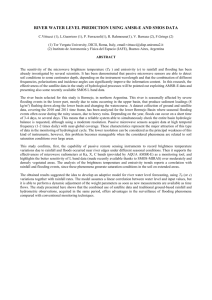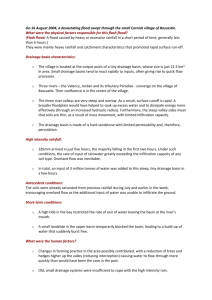abs245_article
advertisement

1 Climate change and water availability in North-West Algeria: Investigation by stable water isotopes and dendrochronology Luc Lambs a and Mohamed Labiod a,b a: CNRS-Ecolab, 29 rue Marvig, F-31055 Toulouse Cedex (lambs@cict.fr) b: Laboratoire de Foresterie, Université de Tlemcen, Algeria. Corresponding author : lambs@cict.fr Web site: http://www.ecolab.ups-tlse.fr/spip.php?article555&lang=en Since the seventies, the rainfalls incomes are getting lower along the North African coast, while the demographic pressure increases, and such the water need. Here, we present the situation of the Tafna river basin, centre on the city of Tlemcen, in the North-West of Algeria. Outside the rainfall data and water level of the Béni Bahdel dam, water isotopic signature and tree ring analyses were used to better understand the climate change influence and the water circulation in this area. Keywords: water resources, riparian vegetation, Tafna bassin Introduction The Tafna River is the last stream in the North West of Algeria, close to the border of Morocco, and take is source around the Tlemcen Mountains (1400 m). The Tafna basin has a surface of 7250 km2 (Dahmani et al. 2003). The basin is localised in sub-humid to semi-arid region and many of the Tafna River's tributaries are intermittent streams, with rainfall ranging from 300 to 700 mm/year. Two area can be described: the upper South part composed by chalk plateau and wetter condition due to the altitude, and the lower North part of low drier land. For the water need of the Oran city, a first dam were build on the Tafna river around 1940, just on the end of the upper plateau. The excess of water should have been used to irrigate the lower lands. In that time, the mean rainfall value was 560 mm/year and such could regulate a volume of 74 million m3 per year. But since, the mean rainfall was only of 450 mm during 1940 and 1974, and after the dry period of the seventies, the mean rainfall lower at 342 mm for 1975-2005 (Adjim et al., 2005). The Tlemcen and Maghnia populations' growth gave two types of problem. The first concerns water supply for population, industry and irrigation. All surface- and ground waters, already scarce were exploited, and more recently also deep pumping. The second impact on rivers is pollution, which has reached all the lowest rivers courses. Effects become more obvious during low flow, and some rivers become only fed by wastewaters (Gagneur, 2006). Also, especially in the lower part of the Tafna river basin, since the seventies many wells and small rivers become dry, and important dye-back of poplars (Populus alba L.) were observed. At first, only the increase of insect attack were notice for these trees, before a study reveals that the original cause of this poplar sanitary degradation was due to the lack of water (Labiod et al. 2007). Here with the help of the stable water isotope, we try to understand the water circulation along the Tafna basin, its storage within the karst system, and how its affect the riparian vegetation, important for the water bioremediation. An attempt was also made on older forest to get an idea on the climat change effect on vegetation growth. 2 Results Figure 1 gives the general shape of the Tafna with its numerous tributaries originates around the Tlemcen Mountains. The first stable isotope sampling in 2006 (Lambs and Labiod 2006) on 18O, compare the variation between the upper basin river and sources, and the sources around the city of Tlemcen. The mean values for the two sites differ of about one unit, respectively –7.52 +/- 0.26 and –6.51 +/- 0.25, which show the different rainfall origins. More surprising is the stable value over the season, even for the rivers plateau confirming the importance of the karstic reservoir, with a buffer system of at least over 6 months. Interesting is the sampling in the Mansourah village, above the city of Tlemcen direction Southwest, just on the edge of the plateau, where is produce mineral water. The agricultural well displays a delta 18O isotope value of –6.52, where as the deeper drilling (70 m) were is pomp the mineral water has a more depleted value of –7.52, as the water in the higher Tafna. In this case a double ground water should exist. A second isotope investigation were undertaken in spring 2008, looking on both Deuterium and 18O along the Tafna river course, from the underground source until the sea estuary. The conductivity of the main spring and tributaries is very high since the beginning (around 600 µS), due to the time of residence and chalk soil, and increase down stream with the evaporation, pollution and salinity intrusion. The 18O value for the lower basin range between –3.4 and –5.4 . Except the surface water of the Beni Bahdel dam, the water with the higher salinity (1100 to 2000 µS) has also the lower Deuterium excess (2.4 to 5.8). All the altitude sources of the Tafna river system presents similar 18O value, depleted in heavy isotopes: Tafna it-self -7.8, Khemis –7.6, Sebdou –7.2, Isser -7.4, Chouly –7.4 and on the Mouillah –7.2, on the Morocco side. The world wide and Atlantic reference for the water isotopic measurement is the Global Meteoric Water Line (GMWL) with a slope of 8 and ab deuterium excess of 10 as defined by Craig in 1961. But for the Mediterranean Sea, due the close basin effect, the Deuterium excess is much higher, and for the West part of this sea basin, Western Mediterranean Meteoric Water Line (WMMWL) this value is around 14 (Celle et al. 2001). For our altitude Tafna sources and tributaries, the Deuterium excess range between 10 and 14, so between the GMWL and the WMMWL, showing both the Atlantic and Mediterranean rainfall influence (see Figure 3). After the first dam at Beni Bahdel, the value for the Tafna river become less negative: –5, around the same value is found more West for Oued Nechef, which take it source behind the city of Tlemcen, and also value taken by the Isser river in its lower part. On the Tafna side after the other low altitude dams, the isotopic value range from –4 to –3. The calculated deuterium excess shows that an higher evaporation process for some places (value between 1.4 and 4.7) but also for the Sebdou river (5.8) where the pollution and human influence are important as the high ions content reveal it, with a conductivity of 900 µS. The calculated slope of 6.2 from the Tafna sources until the downstream water sampling shows an important evaporation, as this water sampling was undertaken between February and April. This kind of sampling along the whole Tafna river is not possible in summer due the drying of many river sections in the lower part of the basin. The main riparian tree species is the white poplar. On the upper basin, high growth rate was found for trees growing very close to the river or close to irrigation canal, mean value from 0.5 to 1 cm/year, whereas in lower part much smaller rate were found, and impact by insect attacks. Most of the old trees display lower growth rate since the seventies-eighties. For the tree age determination, no tree over 45 year was found. To get a wider view of the rainfall 3 influence on tree growth over the last decades, we had to focus outside the riparian trees on conifer trees. Over the city of Tlemcen, there is nice Aleppo pine forest and more isolated trees as “Oxycedar Juniper” (Juniperius oxycedrus) and “Thuya de Berbéris” (Tetraclinis articulata), some of these trees being over 100 years old. Figure 4 reports typical dendrological curves versus the annual rainfall. Here also a decrease in growth could be seen since 1975. Discussion The Tafna bassin was mainly investigated under geologic (Collignon 1986), limnologic (Gagneur 1994, 2006) and hydrologic (Dahmani et al 2003, Adjim et al. 2005) approaches. With the absence of long meteorological series, the drying of the river and the karstic system, it was difficult to study the whole water circulation. The isotopic techniques allow to follow the water circulation and determine the water origin even with karstic system as in the upper basin, and to evaluate the evaporation process in the lower part. The first 18O measurement in this area was made by Blavoux in 1984-86, but seems to be shifted (about one unit more negative) with the values obtained latter by other authors. This could come by exceptional cold conditions during the sampling period. The next and more complete isotopic analysis were published by Azzaz et al (2008), and made in April 1991 on about 30 sources and wells on around the Tlemcen Mountains. They show for the first time the double influence, Mediterranean and Atlantic, on the altitude rainfall as seen for the deuterium excess value. We have confirmed this mix origin for the headwater for the main tributaries of the Tafna River, for the whole Tafna basin and also for the Morocco as for the Mouillah tributary. They also measure also the resident time of karstic water, and found only a source with deeper reservoir and longer storage (around 25 years). On our side, the absence of seasonal effect show that the water is store at least 6 months. The city of Algiers is only one the Global Network of Isotopes in Precipitation (GNIP) by IAEA agency. Rainfalls isotopes data is available during 1998 and 2004. The evaporation slope that we have found over the Tafna basin (6.18) is intermediate between the one of Algier (slope 4.81) and the closest GNIP station on the west part: Bab Bou Idir (7.34), an altitude station in Morocco. The effects causes by the lack of rainfall and tree growth are also scarce. The study of Labiod and al (2007) have show that numerous poplar in the lower basin present low growth rate and high insect attack. The diminution of the riparian vegetation has a negative effect on flood buffering, local water vegetation and water bio-remediation. The agriculture surface land increase and such the nitrate input, but the natural wetland depuration area diminishes. On a more longer time investigation time, dendro-chronological and sanitary studies have been recently done on century old cedars in the Chréa forest in few hundred km more East (Sbabdji et al. 2008). Also in that case, a growth decrease was observed since the seventies. Conclusion The upper Tafna River is not easy to study since it is formed by a wide karstic and cave system with up to 3.4 km long Underground River. Even some water outcome from this system has been found on the Marocco side. The total underground water of this system is estimated to 10 billions of m3 and thus certainly buffer the seasonal rainfall fluctuation, but also delay the lack of water for the following years. This means that the real effect of the rainfall over the head basin will be only visible in the following year. The lower Tafna basin has now four additional water dams that increase the water evaporation and enhance the 4 sediment retention. The apparent climate change with lower precipitation since the seventies, the diminution of the riparian forest and other forests have a negative effect, and the increasing human pressure will certainly enhance the water problem. More hydrologic and environmental studies are needed to get more data in view to better manage the water resource. Acknowledgments: We are grateful to H. Adjim (University Tlemcen) and J. Gagneur (Ecolab, Toulouse) for interesting discussion on the Tafna basin hydrology and to F. Guibal (Imep, Aix en Provence) for advice for the Aleppo Pine dendrochronologic approach. References : Adjim H., Djedid A., Bekkouche A., 2005. Impact de la sécheresse de 1974-2002 sur les apports du barrage de Béni Bahdel (Nord-Ouest Algérie). Watmed 2, Marrakech 14-17 novembre. Azzaz H., Cherchali M., Meddi M., Houha B., Puig J.M., Achachi A., 2008. The use of environmental isotopic and hydrochemical tracers to characterize the functioning of karst systems in the Tlemcen Moutains, northwest Algeria. Hydrogeology Journal, 16, 531-546. Blavoux B., 1978, Étude du cycle de l'eau au moyen de l'oxygène 18 et du Deutérium. PhD Thesis, Paris University Paris, pp. 333. Celle H., Travi Y., Blavoux B., 2001. Isotopic typology of the precipitation in the western Mediterranean region at three different time scales. Geophys. Res. Lett. 28, 1215-1218. Collignon B., 1986. Hydrogéologie appliquée des Monts de Tlemcen (Algérie). PhD Thesis, Avignon University, France, pp. 116. Craig H.,1961. Isotopic variations in meteoric waters. Science, 133, 1702-1703. 5 Dahmani B., Hadji F., Allal F., 2003. Traitement des eaux du bassin hydrographique de la Tafna. Desalination, 152, 113-124. Gagneur J., 1994. Flash floods and drying up as major disturbances upon benthic communities in North-African wadis. Verh. Internat. Verein. Limnol., 25, 1807-1811. Gagneur J., 2006. Twenty years research on the Tafna ecosystem, an Algerian temporary stream. Verh. Internat. Verein. Limnol., 29, 1998-2002. Labiod M., Haddad A., Bouhraoua R., Khelil A.M., Lambs L., 2007. Devenir du peuplier blanc (Populus alba L.) dans le Nord-Ouest Algérien. Diagnostic sanitaire de quelques peuplements sur la région de Tlemcen. Foret Méditerranéenne, 28, 255-262 Lambs L., Labiod M., 2006. Etude hydrologique et dendrochronologique du haut bassin de la Tafna, NW Algérie. 4 ième Journées de la Société Française des Isotopes Stables, Nantes, 1114 Septembre. Sbabdji M., El Hadi O., Haddad A., Lambs L., 2008. Cedar tree growth (Cedrus atlantica Manetti) in Chréa National Park, Algeria, and the influence of defoliation by the pine processionary caterpillar (Thaumatopoea pityocampa Schiff). Annals Forest Sciences (accepted) 6 Figure 1 : the Tafna river bassin. 7 -4 1 2 -5 n=6 n=5 18O (VSMOW) n=7 n=6 -6 -7 -8 higher plateau Tlem cen area Figure 2 : comparison of the mean water isotopic value (18O) for the upper Tafna basin and the middle Tafna basin, Tlemcen area, during Mars 2006(dark grey) and August 2006 (light grey). n represent the number of different water sample. 8 Tafna Feb-April 2008: 18O versus D WMMWL Hammam dam GMWL downstream -20,00 Isser downsream Tafna le pont Hammam dam Oued Sikkak Tafna downstream -30,00 Mouillah delta D Mouillah downstrem Isser bent Oussif -40,00 Chouly -50,00 Tafna sources Beni Bada dam Oued Nechef y = 6,1775x - 2,2616 R2 = 0,9346 Ouldja Isser Aïn Sebdou Khemis -60,00 -9,00 -8,00 -7,00 -6,00 -5,00 -4,00 -3,00 -2,00 delta 18O Figure 3 : Deuterium and 18Oxygen characteristics of the Tafna water during February and April 2008. pinus Juniperius 12 10 8 pluvio/100 10 6 8 4 6 2 4 0 2 -2 0 -4 1940 1945 1950 1955 1960 1965 1970 1975 1980 1985 1990 1995 2000 2005 years Annual rainfall (100 mm) Tree radial increase (mm) 14 9 Figure 4 : Comparison of the annual conifer tree growth (mm/ year) on the forest above Tlemcen and the annual rainfall (in hundred of mm/ year), this last curve being shift to avoid overlapping, showing the corresponding decrease since 1975.






